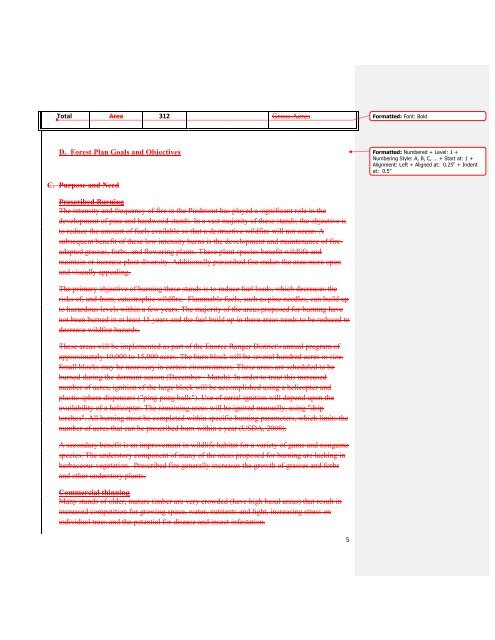DECISION MEMO Prescribed Burn and Commercial Thinning ...
DECISION MEMO Prescribed Burn and Commercial Thinning ...
DECISION MEMO Prescribed Burn and Commercial Thinning ...
You also want an ePaper? Increase the reach of your titles
YUMPU automatically turns print PDFs into web optimized ePapers that Google loves.
Total Area 312 Gross Acres<br />
D. Forest Plan Goals <strong>and</strong> Objectives<br />
C. Purpose <strong>and</strong> Need<br />
<strong>Prescribed</strong> <strong>Burn</strong>ing<br />
The intensity <strong>and</strong> frequency of fire in the Piedmont has played a significant role in the<br />
development of pine <strong>and</strong> hardwood st<strong>and</strong>s. In a vast majority of these st<strong>and</strong>s, the objective is<br />
to reduce the amount of fuels available so that a destructive wildfire will not occur. A<br />
subsequent benefit of these low intensity burns is the development <strong>and</strong> maintenance of fireadapted<br />
grasses, forbs, <strong>and</strong> flowering plants. These plant species benefit wildlife <strong>and</strong><br />
maintain or increase plant diversity. Additionally prescribed fire makes the area more open<br />
<strong>and</strong> visually appealing.<br />
The primary objective of burning these st<strong>and</strong>s is to reduce fuel loads, which decreases the<br />
risks of, <strong>and</strong> from, catastrophic wildfire. Flammable fuels, such as pine needles, can build up<br />
to hazardous levels within a few years. The majority of the areas proposed for burning have<br />
not been burned in at least 15 years <strong>and</strong> the fuel build up in these areas needs to be reduced to<br />
decrease wildfire hazards.<br />
These areas will be implemented as part of the Enoree Ranger District's annual program of<br />
approximately 10,000 to 15,000 acres. The burn block will be several hundred acres in size.<br />
Small blocks may be necessary in certain circumstances. These areas are scheduled to be<br />
burned during the dormant season (December - March). In order to treat this increased<br />
number of acres, ignition of the large block will be accomplished using a helicopter <strong>and</strong><br />
plastic sphere dispensers ("ping-pong balls"). Use of aerial ignition will depend upon the<br />
availability of a helicopter. The remaining areas will be ignited manually, using "drip<br />
torches". All burning must be completed within specific burning parameters, which limits the<br />
number of acres that can be prescribed burn within a year (USDA, 2008).<br />
A secondary benefit is an improvement in wildlife habitat for a variety of game <strong>and</strong> nongame<br />
species. The understory component of many of the areas proposed for burning are lacking in<br />
herbaceous vegetation. <strong>Prescribed</strong> fire generally increases the growth of grasses <strong>and</strong> forbs<br />
<strong>and</strong> other understory plants.<br />
<strong>Commercial</strong> thinning<br />
Many st<strong>and</strong>s of older, mature timber are very crowded (have high basal areas) that result in<br />
increased competition for growing space, water, nutrients <strong>and</strong> light, increasing stress on<br />
individual trees <strong>and</strong> the potential for disease <strong>and</strong> insect infestation.<br />
5<br />
Formatted: Font: Bold<br />
Formatted: Numbered + Level: 1 +<br />
Numbering Style: A, B, C, … + Start at: 1 +<br />
Alignment: Left + Aligned at: 0.25" + Indent<br />
at: 0.5"

















